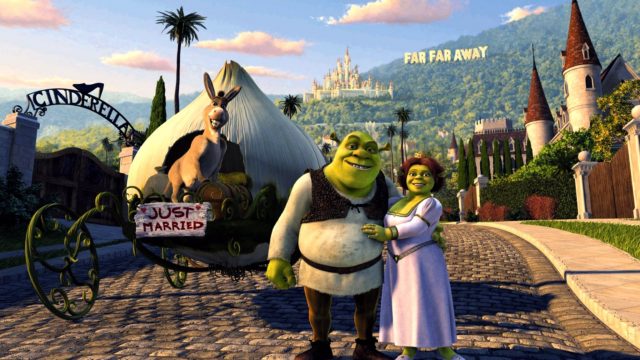If you judge a sequel purely on how much it improves on the original, then Shrek 2 may be one of the greatest sequels in the history of film. The original Shrek is funny enough, cute enough, diverting enough, but it doesn’t quite go far enough in any direction. It’s a straightforward tale of true beauty lying on the inside, and yet also a knowing parody of the fairytale universe (more explicitly the Disney universe) by way of snarky postmodernism. It wants to tell a sincere story of Shrek’s self-actualization and reject that story in the same gesture; to have its cake and eat it too. This is where Shrek fails. This is also where the sequel succeeds.
Some of the greatest improvements of Shrek 2 are purely formal: the animation is a lot better, the pace is faster and evener, there is at least one classic joke in every scene and often far more, there are more characters with greater complexity, and the characters that had been introduced in the first film gain greater dimension and interiority, particularly Fiona and Donkey. But the primary strength of Shrek 2 compared to its prequel is its full-throated embrace of postmodernism and metanarrative, and its expansion of its critiques from just Disney movies to character archetypes, social norms, and the media industry itself.
Comparing the antagonists of these two films will illustrate this change in priorities very clearly. Lord Farquaad, John Lithgow’s tiny, sputtering fop, is a king concerned only with power and beauty, who pursues Princess Fiona for that sole purpose. He is, quite literally, a short man in a tall tower. The king in Shrek 2, though effectively in charge of Far Far Away, is a pitiable figure under the thumb of the Fairy Godmother, the film’s true antagonist and its true source of power. She is a media figure, advertising a happy ending, who brews potions to influence people in secretive and subtle ways. She appears to Fiona first as a friend and then appears again to the King to blackmail him. She wields her power by keeping secrets, influencing people through unnatural means, and constantly adapting her plans. She desires Prince Charming and Fiona’s union not for herself, but for her vain son Prince Charming, one of cinema’s first CGI himbos. The villain of Shrek is quite literally Disney CEO Michael Eisner. The villain of Shrek 2 is the architect of fantasy narrative itself, the unspoken societal norms that force stories into convention.
In the first Shrek, we get a straightforward message about outward beauty’s lack of correlation with inner beauty. About how an ogre is not an evil creature, but worthy of love. In this film, we get the corollary of that message: that outward beauty conceals inner ugliness, that surfaces are often intentionally designed to mislead, and that a culture obsessed with surfaces will always be concealing a dark engine that powers those surfaces. It is a film that truly makes good on that common observation that so many of the Brothers Grimm’s fairy tales are based off of death, suffering, or other unbelievably dark subjects.
This contrast is present formally: look at the visual difference between the kingdom of Far Far Away (modeled after Hollywood, the most surface-obsessed place in all the land) and the seedy bar where King Harold goes to put a price on Shrek’s life, where all the ugly and “undesirable” fairytale creatures go. This is the dark underbelly that powers the illusion of fantasy, a hive of scum and villainy that will do the dirty work that the king requests in order to uphold his squeaky-clean image.
Or look at the potion factory where the Fairy Godmother brews her plot magic. As Shrek and Donkey sneak in, they adopt the disguise of union reps, here to free the downtrodden potion-brewing underclass (all rendered visually as small creatures with mysterious bodies draped in hazmat-like white suits). “Are you feeling exploited?” Shrek asks. “We don’t even have dental,” says the clerk. This joke, a bit out of place but still very funny, speaks to the politics of Shrek 2 — it positions itself as a film strictly against hierarchies and those who enforce them. Once you notice things like this, you find them everywhere, from the film’s specific concern with advertising, to its parody of Cops in which Puss in Boots calls the cops “capitalist pigdogs” before they bust him for possession of catnip, to the ultimate revelation that the king of Far Far Away attained his position through the same deceit and scheming with which he aims to preserve it.
One of the more ingenious aspects of Shrek 2’s narrative design occurs when Shrek steals the happy ending potion and drinks it. This is Shrek 2’s central narrative device, that its hero has stolen this potion and used it to transform into a hunky human version of himself. Yet the Fairy Godmother is so cunning that this gets folded back into her evil plan: she is able to send Prince Charming to greet Fiona and pretend to be Shrek, using his good looks to fool her into thinking he is the transformed Shrek.
This thread carries through to the end of the film, where another comparison to the first film is illustrative. In the first film, Shrek and Fiona vanquish Farquaad and then kiss while a studio audience is cued to “awwww” at their sweet embrace. In the new film, Shrek and Fiona have the chance to kiss in their new human form, but choose to wait a couple moments after midnight, rejecting their new good-looking bodies in favor of their old ones. The first film ends with an acceptance of ugliness. This film ends with a complete rejection of beauty.

